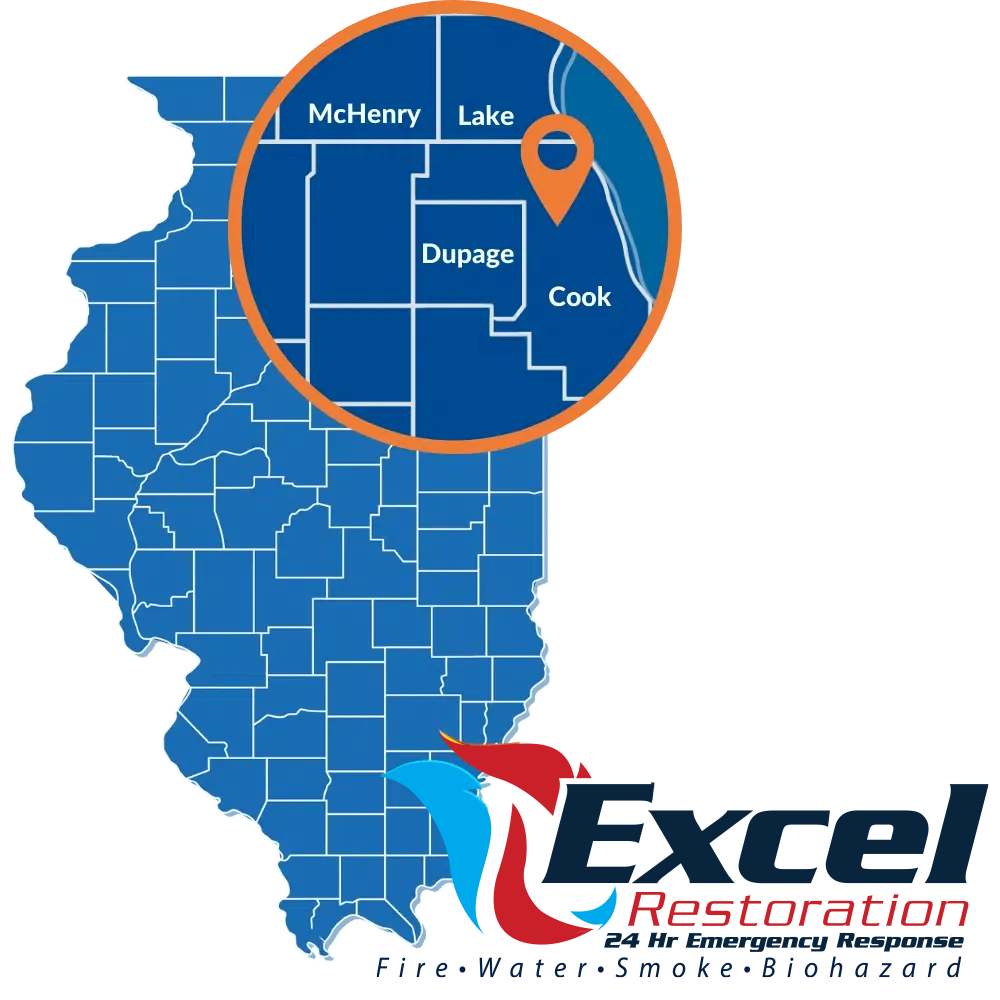Water damage in your home can be a stressful experience that requires immediate attention. However, water damage also poses additional risks to your home and health. One of the most significant risks associated with water damage is the likelihood of mold growth. Mold can develop quickly, and if left unattended, it can cause significant damage to your home and pose health hazards to you and your family.
In this section, we will explore how likely mold growth is after water damage occurs in your home. We will also discuss the factors that contribute to mold growth, allowing you to understand the risks and take necessary precautions to prevent mold development.
Key Takeaways:
- Mold growth can occur rapidly after water damage.
- Understanding the role of moisture in mold growth is crucial in assessing the likelihood of mold.
- Certain building materials are more susceptible to mold growth than others.
- Mold exposure can lead to significant health implications.
- Proactive steps can be taken to prevent mold growth after water damage occurs.
The Role of Moisture in Mold Growth
Moisture is a crucial factor in the development of mold. It provides the necessary environment for mold spores to grow and spread. When water damage occurs in your home, it’s important to act quickly to dry out the affected areas and prevent mold from taking hold. The longer the moisture remains, the greater the likelihood of mold growth.
Excess moisture from water damage can come from various sources, including:
- Flooding
- Leaky pipes
- Roof leaks
- Damp basements or crawl spaces
- Condensation from air conditioning units
When these sources of moisture are not addressed promptly, they create an ideal environment for mold to thrive. Mold spores can begin to grow within 24-48 hours of exposure to moisture, making it critical to begin drying out affected areas as soon as possible.
It’s also important to note that mold growth can occur even in areas with high humidity levels, even if there is no visible sign of water damage. This is why it’s essential to maintain proper ventilation and moisture control in your home to prevent mold development over time.
Timeframe for Mold Growth
Mold growth can occur rapidly after water damage, but the timeframe for development can vary based on several factors. Generally, mold can start to grow within 24 to 48 hours after water damage, but it can take up to several weeks or even months for mold to become visible.
The specific timeframe for mold growth depends on various factors, including the type of mold present, the amount of moisture and humidity in the environment, and the temperature. For example, mold thrives in warm and moist environments, making it more likely to grow in high humidity areas like bathrooms and kitchens.
It’s important to note that even if you don’t see any visible mold growth, it doesn’t necessarily mean that mold isn’t present. Mold can grow behind walls, under carpets, and in other hidden areas, making it difficult to detect without professional equipment.
If you suspect that mold may be growing in your home after water damage, it’s crucial to take immediate action to prevent its spread. The longer mold is left to grow, the harder it is to remove and the greater the potential health risks it poses.
Building Materials and Mold Susceptibility
When it comes to mold growth, not all building materials are created equal. Some materials are more prone to mold growth than others, and understanding this susceptibility can help you take effective preventive measures.
Materials like drywall, carpeting, and insulation are particularly susceptible to mold growth. These materials contain organic compounds that provide an excellent food source for mold spores. In contrast, materials like concrete and metal are less likely to foster mold growth.
To minimize the likelihood of mold growth on building materials, it’s important to address any water damage quickly. Water-damaged materials should be removed and replaced if possible. If you’re unable to remove the affected materials, it’s essential to dry them out as quickly as possible.
| Materials Prone to Mold Growth | Materials Resistant to Mold Growth |
|---|---|
| Carpets | Concrete |
| Insulation | Metal |
| Drywall | Plastic |
As you can see from the table, certain materials are significantly more prone to mold growth than others. By being aware of this susceptibility, you can take proactive steps to protect your home from mold development.
Finally, it’s important to note that high humidity levels can increase the likelihood of mold growth on building materials. If your home has high humidity levels, consider investing in a dehumidifier to help regulate the moisture in the air and prevent mold growth.
Remember, prevention is the key to avoiding mold growth on building materials. By being aware of the materials that are most susceptible to mold and taking proactive steps to address water damage and regulate moisture levels, you can create a healthy living environment for you and your family.
Health Risks Associated with Mold
When you experience water damage in your home, mold growth can become a serious concern. Not only can it cause damage to your building materials, but it can also have significant effects on your health. Mold exposure can lead to a variety of health risks and illnesses, particularly for those with preexisting conditions or weakened immune systems.
Mold health risks:
- Respiratory problems such as coughing, wheezing, and difficulty breathing
- Allergic reactions including sneezing, runny nose, red eyes, and skin rash
- Headaches and dizziness
- Fatigue and weakness
- Neurological symptoms such as memory loss and mood changes
- In rare cases, exposure to toxic mold can cause more severe health problems such as neurological damage and even death
The health effects of mold can vary depending on the type of mold present and the duration of exposure. It is important to address any water damage promptly and take measures to prevent mold growth in order to mitigate the risk of health complications.
Mold-related illnesses:
| Type of Mold | Associated Illnesses |
|---|---|
| Aspergillus | Allergic reactions, respiratory infections, and lung inflammation |
| Stachybotrys | Toxic mold syndrome, characterized by headache, fatigue, respiratory problems, and neurological symptoms |
| Penicillium | Respiratory infections and allergic reactions |
| Cladosporium | Allergic reactions and respiratory problems |
If you suspect mold growth in your home, it is important to seek professional assistance for removal and cleanup to ensure the safety of your household. Taking proactive measures to prevent mold growth can also contribute to a healthier living environment.
Preventing Mold Growth After Water Damage
Water damage is a serious issue that can lead to mold growth if not addressed promptly. Here are some tips to prevent mold after water damage occurs:
- Dry affected areas quickly: The key to preventing mold growth is to dry the affected areas as soon as possible. Use fans, dehumidifiers, and open windows to help with the drying process.
- Remove wet items: Remove any wet items such as carpets, furniture, and other personal belongings from the affected area to prevent further damage and to aid in the drying process.
- Clean and disinfect: Use a mixture of water and bleach to clean and disinfect the affected area. Be sure to wear protective gear such as gloves and a mask while cleaning.
- Monitor humidity levels: Use a hygrometer to monitor the humidity levels in your home. Keep the humidity levels below 60% to prevent mold growth.
- Fix leaks: If you have any leaks, fix them promptly to prevent water damage and mold growth.
- Keep your home ventilated: Ensure proper ventilation in your home by opening windows and using exhaust fans in kitchens and bathrooms to reduce humidity levels.
By following these mold prevention tips, you can minimize the likelihood of mold growth after water damage occurs in your home. Remember, it is essential to address water damage promptly to prevent mold growth. If you are unsure of how to handle the situation, seek assistance from a professional mold remediation company.
Professional Mold Remediation
If you suspect or confirm mold growth in your home after water damage, it’s crucial to seek professional mold remediation services. Trying to remove mold on your own can be dangerous and ineffective, potentially causing the spread of mold spores and exposing you to harmful toxins.
Professional mold removal experts have the necessary equipment, training, and experience to safely and effectively remove mold from your home. They use specialized techniques to contain and remove mold and prevent it from returning, ensuring the health and safety of your home and family.
When choosing a mold remediation company, look for one that is licensed, certified, and highly rated by previous customers. You can also ask for references and check their credentials with relevant industry organizations.
Remember that professional mold remediation can be a significant investment, but it’s worth it to ensure the safety and health of your home and family. Don’t hesitate to seek assistance if you suspect mold growth in your home after water damage.
Conclusion
As you now know, water damage can lead to mold growth in your home. It is important to recognize the role of moisture, the timeframes for mold development, and the susceptibility of building materials to mold. By taking proactive steps to prevent mold growth and addressing water damage promptly, you can create a healthier living environment for you and your loved ones.
However, in some cases, professional mold remediation may be necessary to address mold growth after water damage. It is important to seek expert assistance when needed and follow their guidance for proper mold removal and cleanup.
In conclusion, understanding the likelihood of mold growth after water damage and taking the necessary precautions can help you avoid potential health risks and maintain a safe and healthy home. If you have experienced water damage in your home, be sure to take action promptly and implement prevention measures to avoid mold growth.
Thank you for reading this article on mold growth after water damage, and we hope you found this information helpful in protecting your home.
FAQ
How likely is mold after water damage?
The likelihood of mold growth after water damage depends on various factors such as the extent of the damage, the duration of exposure to moisture, and the presence of favorable conditions for mold growth. It is important to address water damage promptly and take preventive measures to minimize the chances of mold development.
What is the role of moisture in mold growth?
Excess moisture provides an ideal environment for mold to thrive. When water damage occurs, the increased moisture levels create conditions that promote mold development. Proper drying and removal of water sources are crucial in preventing mold growth.
How long does it take for mold to grow after water damage?
The timeframe for mold growth varies depending on several factors, including the type of mold, temperature, humidity levels, and the extent of water damage. In some cases, mold can start growing within 24 to 48 hours after water damage occurs. However, it is important to note that mold growth can occur at different rates and may take longer to become visible.
Which building materials are more susceptible to mold growth?
Certain building materials, such as drywall, wood, and carpeting, are more prone to mold growth. These materials provide organic matter and moisture retention, creating an environment where mold can thrive. Regular inspection and proper maintenance of these materials can help mitigate the likelihood of mold growth.
What are the health risks associated with mold growth?
Mold exposure can lead to various health issues, including allergic reactions, respiratory problems, and exacerbation of existing conditions such as asthma. Prolonged exposure to mold can have more severe health effects. It is essential to address mold growth promptly to safeguard the health of occupants.
How can I prevent mold growth after water damage?
There are several preventive measures you can take to minimize the likelihood of mold growth after water damage. These include promptly drying and cleaning affected areas, addressing any underlying moisture issues, improving ventilation, and using dehumidifiers. It is also important to monitor and maintain proper indoor humidity levels.
When should I consider professional mold remediation?
Professional mold remediation may be necessary in cases of extensive mold growth, persistent moisture problems, or if individuals in the household have existing health conditions that may be worsened by mold exposure. An experienced mold remediation specialist can assess the situation, perform necessary testing, and safely remove the mold.

















